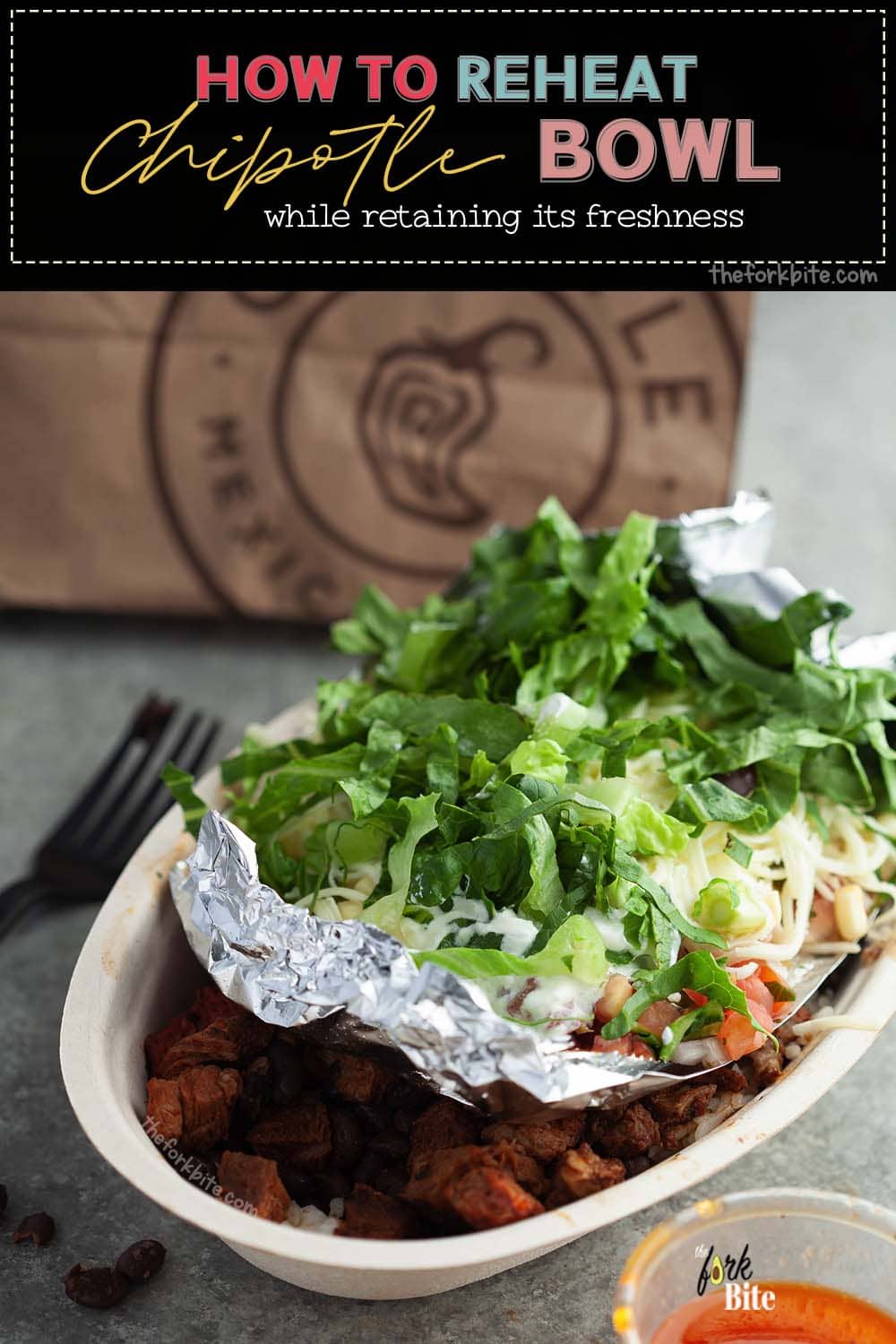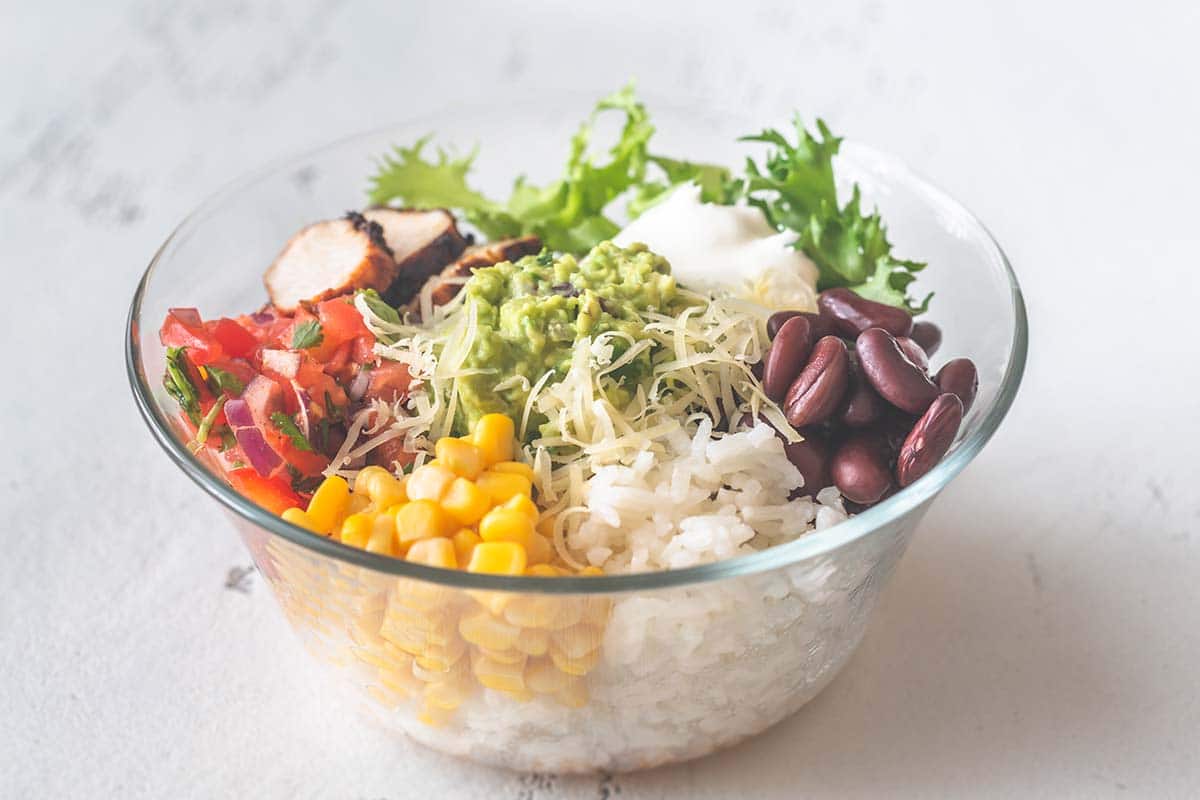Are you a lover of Chipolte bowl? Does that spicy, smoky hit galvanize your taste buds like nothing else? It is so good that you would have to be crazy to throw any leftovers away. But after reading this article on how to reheat Chipotle bowl, you will never have to. You'll be able to reheat and eat any Chipotle leftovers, and they will taste just as good as when it was first made.
The chipotle bowl is crammed with the yummiest ingredients you can imagine, making it one of the tastiest dishes you could ever wish to eat. Once you've finished reading what I have to tell you, you will know all about reheating Chipotle bowl in a way that reproduces all its original freshness.
Jump to:
Quick Answer: Reheating Chipotle bowl in a microwave is likely to be safe as long as you use a microwave-friendly container. But there are other schools of thought on this subject, and I am about to layout if you continue reading.
Regardless of whether you didn't get your take-out back home quickly enough, or you made too much, and you have some leftover, you might be faced with the slight dilemma of needing to reheat a burrito.
What Is a Chipotle Bowl?
Chipotle bowl, referred to as chipotle burrito bowl or just burrito bowl, is, in essence, a burrito minus the tortilla, one of the most popular Mexican dishes on the planet. It consists of rice, beans, and veggies, plus a few other delicious ingredients. They all come together, served in a disposable bowl.
The difficulty arises when you happen to have some leftovers lurking in your refrigerator.
What to do when you intend to eat it tomorrow? How do you go about reheating chipotle bowl? How about microwaving?
Chipotle bowls might be environmentally friendly, but that doesn't necessarily mean that you can microwave them. While some people maintain that you can microwave them providing you remove the aluminum lid, others think it is preferable to use a microwave-safe container.
Ingredients in a chipotle bowl
The chipotle bowl is a variant on the classic burrito, but less the tortilla. Therefore, ingredient-wise, it contains similar things that you expect to find in your favorite burrito, but instead of being served in a pancake, it is served in a bowl. It can include:
- Avocado
- Black beans
- Cheese
- Cilantro
- Corn
- Lettuce
- Protein
- Rice
- Salad
- Tomatoes
Anything else you might fancy
With some generic ingredients such as cheese, protein, or salad, you can include them in the format you prefer. For example, in terms of the protein, you could go for ground beef, chipotle chicken, chipotle pork, ground turkey - whatever you like.
The choice isn't just limited to what goes into the chipotle, but also what goes onto it. There is a wide range of toppings or dressing that would go with your superbly cooked chipotle bowl, like avocado cream, Greek yogurt, guacamole, sour cream, or salsa.
Because it is so easy to personalize chipotle bowls with your favorite ingredients, it makes them very popular with the masses. You can make up your creative concoction, just the way you like it, and have it available to eat for several days.
Can you store it in the fridge?
You sure can. If your eyes were bigger than your belly and you've got some chipotle bowl leftovers, you can keep them in the fridge to have a snack or quick meal. It's by knowing the best way to reheat the remnants that pose the problem.
Can you microwave the entire thing - including the bowl? To answer that question satisfactorily, we first need to know what the bowl is made of.
The majority of chipotle bowls can be refrigerated for up to four or five days. But to get the best results for reheating and eating later, the best thing to do is separate it into its different elements before putting them into the fridge.
First, you should separate any lettuce, sauce, or dressing. If you leave it together, fair enough, but it will get soggy.
The next thing to discuss is how best to reheat the chipotle bowl, with all its elements, to make sure that they taste as delicious as when cooked initially.
How to reheat Chipotle bowl
Okay. To keep things as fresh as possible, you hopefully followed the recommendation and store your sauce and lettuce separately, so the sauce didn't turn sour, and the lettuce didn't go all weak and wilted. Nobody likes weak, wilted lettuce - it's nasty.
The fact is that burrito bowls are made from various things, some of which reheat alright, but some don't. So, whatever the method of reheating, the dos and don't need to be listed each time.
You must remove:
- Any fresh vegetables
- Guacamole
- Lettuce
- Salsa
- Sour cream
The only things you should be reheating are beans, meat or tofu, and rice. It means that there will be serval steps to the process, but trust me - it will be well worth it.
The skillet method:
- Once you have removed all of the things that should not be reheated, you can put the rest into a skillet and cook on a medium to low heat setting for between five and seven minutes.
- Because the ingredients are not particularly dense, they will heat through quite quickly. Be careful, though, as not all stoves and skillets are the same. You need to find the right setting for your equipment.
The Microwave Method
-
- The easiest and quickest way of reheating a chipotle bowl is to put all of the ingredients you can reheat into a microwave-safe container and heat it for about one minute.
- After the initial minute, stir and heat again for another minute. If you find it is not warm enough for you, put it back into the microwave and heat in 15 to 20 seconds spells until it's as you like it. Some ingredients, like tofu, for example, take longer to heat through.
- After each additional heating spell, give the ingredients a little stir, It just helps to cook everything more evenly.
- Finally, reheat the chipotle bowl for a further 15 to 20 seconds, remove it from the microwave, add the fresh sauce and lettuce you separated when you refrigerated the chipotle, and enjoy. Tastes excellent, doesn't it?
Whichever reheating method you choose, you can always bring additional freshness to the Chipotle by adding a new sauce or dressing or serving with some nacho chips - or both!

What is a Chipotle Bowl made of?
According to Chipotle's 2018 Sustainable Report, the Mexican Grill chain, every single one of the bowls they use, is made with compostable plant material.
But just because the bowls are environmentally friendly doesn't necessarily mean they are also microwave friendly. The truth is that not all plant fibers and designs of containers are safe to microwave. Some could be flammable!
Some people believe that it is safe to put chipotle bowls into the microwave, providing any aluminum lids are removed. Putting anything metal into a microwave can cause a fire or damage the appliance. Because of this, other folks prefer to use microwave-safe containers just to be on the safe side.
Erring on the side of caution is always recommended, so if in doubt, go down the microwave-friendly container route. However, the choice is yours.
Are Chipotle Bowls Microwavable?
Short Answer: The safest route is to reheat your chipotle bowl is a microwave-safe container.
There is no specific information around that you shouldn't microwave a chipotle bowl; however, a study recently carried out could lead you to believe differently.
Many folks worry about this question because they appreciate that some materials (including some plant fibers) aren't safe to put in the microwave. Asking the question is, therefore, quite reasonable.
To get a better insight into the question, let's take a peek at a recent study on the subject of chipotle bowls.
All Chipotle Bowls are made from compostable materials.
This is good to hear. Using environmentally friendly materials for packaging and utensils is the way that all restaurants should go.
But even if an aluminum lid is labeled as being environmentally friendly, it must not be microwaved. Anything that contains metal is dangerous to microwave.
Even chipotle bowls made from compostable materials may not be safe to microwave.
Why? Take a look at the study we examined below.
Chipotle and Sweetgreen disposable bowls
The Counter.org carried out a study concluding that disposable bowls from restaurant chains like Chipotle, Dig, and Sweetgreen, contain PFAs. But what are PFAs?
PFA stands for Per and Poly-Fluoroalkyl
An industry began producing these circa the 1940s; they are quite abundant in both the environment and the human body. It is because they accumulate and do not break down very readily.
According to studies undertaken by the Environmental Protection Agency, there is solid evidence to suggest that these PFAs can have undesirable health effects in the human body.
How people get exposed to PFAs
People gain exposure to PFAs in several ways.
- From infected soil or water that is used to grow foodstuffs
- Through food packaging
- Via equipment used for food processing
The above instances are only the most common examples. There are a great many other ways that people can be exposed to PFAs.
So can you microwave Chipotle bowl?
If you check chipotle packaging, you won't find anything to suggest you should not microwave a chipotle bowl. But for me, that is not good enough.
To me, PFAs are only the tip of the iceberg. There are probably other chemicals that leach from food packaging into the food itself. Also, were you aware that certain fatty foods such as cheese and meat are more likely to absorb leached chemicals?
Harvard Health says that the FDA qualifies some chemicals as being safe to microwave. These qualifications found in the following conditions.
The duration for which the container will be exposed to microwaves
The quantity of food someone will consume from the container
How much food is present in the container
On the safe side, one of the simplest ways of microwaving your chipotle bowl is to do so in a microwave-safe container or a ceramic dish. It may be a minor inconvenience, but what is that when weighed up against protecting your health?
How do you know if the container is microwave safe?
The only way of establishing whether or not a chipotle bowl or any other kind of bowl is microwave safe is to check the labeling of the container.
If you can't see anything on the product label (if it still has one), check with the product manufacturers. If the company in question is Chipotle, they should be willing to email you with an answer.
Without any such verification, you should assume the containers are not 100% safe for microwaving, or for heating up in any other way either.
Be aware of what's on the label.
If you are looking for a label on a container to confirm that it is microwave-safe, you will often find it on the underside. Sometimes, rather than saying that an item is microwave-safe, a label might indicate the opposite.
If you cannot find a label at all, you can always check on the manufacturer's website. Here are some other things you should bear in mind:
When using a lidded container in your microwave, the best practice is to remove the lid. To stop the food splattering all over the place as it heats through, cover the container with microwave-safe wax paper.
You should not assume that a container is safe to get microwaved because it is made from paper-based material. Always check first. The best way of confirming a particular product's suitability for microwaving is probably to check with the manufacturer.
Microwave safety tips
Here are a few quick tips to promote safe microwaving.
Study any instructions printed on the packaging before microwaving.
-
- Opt for glass containers where possible.
- Use ceramic containers if you have any.
- Search manufacturer's websites for information about microwaving.
How to reheat Chipotle burrito (not the bowl)
If you plan to reheat a Chipotle burrito the next day, you must first ensure that you store it safely. You should:
- Refrigerate it within two hours of cooking and getting it back home if it's a take-out. If the room temperature is above 90°F, refrigerate within one hour, not two.
- The times stated above are the maximum for keeping food out in the high-risk temperature zone, between 40°F and 140°F.
- Starting to read "War and Peace" while your chipotle burrito is sitting there at room temperature is not a good idea.
In the high-risk temperature zone, bacteria reproduce rapidly, and after being out for an hour or two, it could easily make the food dangerous to eat, regardless of how you might reheat it.
Deconstructing and reassembling
Reheating a burrito is not as straightforward as it might be because of its various ingredients. According to food safety standards, proteins such as beef, chicken, pork, or tofu, should be heated to 165°F. You can use a meat thermometer to verify.
Other chipotle burrito ingredients include shredded lettuce, sour cream, etc. - things that don't take kindly to reheating. Hot guacamole and lettuce? - Yuck!!
However, you intend to reheat your burrito - skillet, microwave, etc. - ingredients such as salads and sour cream are best-left cold, as they were original.
For top results, take away any items best left cold, reheat the rest, and reassemble. You don't have to, of course. The choice is yours.
Letting Burritos sit out
If you are reheating a burrito that has been refrigerated, let it stay in its container at room temperature for about half an hour before you start heating it.
You won't die or anything silly if you don't let it rest before reheating, but it won't taste as good as if you had rested it.
Giving it half-an-hour to rest allows all of the ingredients time to get up to room temperature. This then improves the chances of cooking everything evenly. It produces the best results.
3 best ways to reheat Chipotle burritos
1 Oven or Toaster
Reheating a burrito in the oven or toaster oven gives the best results as far as the end-product quality is concerned. The biggest bug-bear is that it takes a little while, bear in mind that reheating it low and slow is the recommendation to ensure you don't burn the tortilla.
-
-
- Start by preheating your oven or toaster oven to a temperature of 225°F.
- Undo the foil wrap (the restaurant supplied the burrito in a smidgin), to allow steam to escape. If you forget to do this, your tortilla will become soggy.
- If you threw the container away, wrap the burrito loosely in aluminum foil, again, leaving a small opening to let any steam out.
- Put the wrapped burrito onto a baking tray and bake for approximately 30 minutes.
-
2 Microwave
Reheating a burrito in the microwave is the quickest and easiest way, but not necessarily the best. Microwaving tends to make any protein somewhat rubbery in texture.
The other problem is that some of the ingredients contain more water than others, so some will get very hot while others are merely warm.
-
-
- As metal foil is a no-no for microwaving, remove any foil wrapper and place the burrito into a microwave-safe dish.
- Drizzle a few drops of water over the tortilla and microwave for one minute.
- Flip it, and if your microwave doesn't have a working turntable, rotate the burrito through 90°.
- Drizzle on a few more drops of water and heat for another minute. Keep repeating the process until you are happy that the burrito is evenly hot.
-
3 Grill
Reheating a burrito on the grill is like heating it in the oven.
-
- Set the grill to low heat, and preheat. While this is happening, loosen the foil to allow steam to escape or rewrap in foil, leaving an opening to let any steam out.
- Put the burrito under the grill, shut the grill door, and grill for around 30 minutes.
- If you want to enhance the quality a little further, add some salad, sour cream or salsa, and sprinkle with grated cheese.








